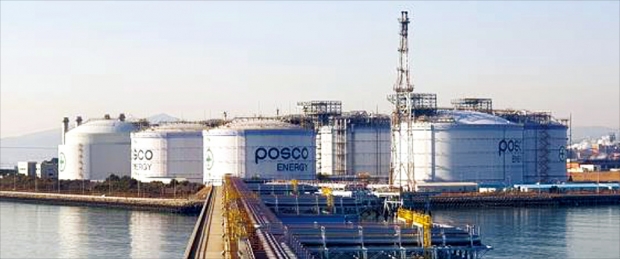Reduced coal power generation and hit a record cold… LNG inventory plummeted
Gas Park, hurry to buy in kind… Private companies also buy at the highest price
Linked to raw material cost from this year… May lead to an increase in city gas rates

As the spot import price of liquefied natural gas (LNG) soared to an all-time high this year, there are concerns that it may lead to a chain rise in domestic city gas and electricity rates. The photo shows POSCO Energy’s Gwangyang LNG Terminal 5 tank, which directly imports LNG. yunhap news
“In the international energy market, Korea can be marked as a’bong’.”
An energy expert said this while watching the recent surge in liquefied natural gas (LNG) prices. They pointed out the dangers of increasing LNG’s energy dependence according to the government’s Green New Deal policy. There are also concerns that uncertainties about domestic city gas and electricity rates may increase.

LNG imports increasing every year
According to the energy industry on the 11th, Korea is considered as a major LNG importer along with Japan and China. Japan is the largest at 8 million tons per year. Korea imports about 40 million tons a year along with China. The volume of domestic LNG imports is increasing every year. In 2018, it soared to 4402 million tons. The government’s official explanation is that the amount of LNG power generation increased as the maintenance volume of nuclear power plants increased in addition to the increase in heating demand due to the cold weather at the time.
Korea Gas Corporation, a domestic energy public company, manages inventory every year in consideration of the weather and power generation in the year. If the LNG inventory exceeds demand, the management cost increases, and proper inventory management is essential.
The problem is that LNG emits less carbon, but it has the disadvantage of being vulnerable to price volatility. Usually, LNG futures prices are linked to international oil prices, which are sensitive to the economy. In the situation where the supply of spot goods is brought in in a timely manner through oil tankers is limited, prices can rise or fall depending on demand. Experts point out that instead of reducing the proportion of coal and nuclear power generation, the larger the proportion of LNG power generation, the more widespread energy costs are.
Gas Corporation to quickly buy in-kind
The recent surge in LNG prices also clearly shows the possibility of sudden price fluctuations caused by such anxiety in supply and demand. According to the Korea International Trade Association, LNG imports in 2019 amounted to 4,075 million tons, down from the previous year (4.42 million tons). 2019 is the warmest winter year since weather observations. According to this, the Korea Gas Corporation made an inventory plan for 2020. As demand for power generation decreased due to the aftermath of the novel coronavirus infection (Corona 19), LNG import prices fell to a record low of 1.675 dollars in April of last year.
However, since the end of last year, a record cold wave has hit the Northeast Asian region, causing an emergency in demand for electricity. As LNG stocks were also sharply decreasing while the operation of coal power plants was being reduced, KOGAS hastily bought LNG spots. LNG prices in the Korean and Japanese spot markets (JKM) soared to $21.453 per million BTU on the 8th as demand surged under limited supply. It is more than four times higher than the $5 of January 2020, just before the coronavirus. An official from the KOGAS said, “For the time being, there is enough stock,” and “if this continues, we have no choice but to buy the spot at a high price.” According to Bloomberg News, a Korean company also bought spot LNG at an all-time high of $27.80 earlier this month.
Will city gas rates continue to rise?
Japan, whose energy supply and demand structure is similar to that of Korea, is suffering from a shortage of LNG supply, and wholesale electricity rates are soaring to an all-time high. On the other hand, the government emphasized that it is unlikely that an increase in LNG prices will lead to an increase in city gas rates. It is explained that the KGAS usually imports about 70% of the total volume in mid- to long-term contracts for 5 to 10 years, so it is not affected by spot prices.
The opinions of experts are different. Unlike general electricity rates, city gas rates are applied in conjunction with LNG raw material costs. The raw material cost item, which accounts for about 80% of the rate, is adjusted in conjunction with the LNG import price. In fact, the government also lowered city gas rates by an average of 13.1% in July last year as the unit price of LNG imports fell in the aftermath of Corona 19. On the contrary, if the import unit price rises, it is a structure that has no choice but to raise the rate unless KOGAS takes a deficit.
The rise in LNG prices is expected to continue for several years in line with the economic recovery trend. Bloomberg News pointed out, “The surge in LNG prices in Korea and Japan showed how large the volatility of LNG along with renewable energy is.” Professor Joo Han-gyu of the Department of Nuclear Engineering at Seoul National University pointed out that “international LNG prices cannot be controlled by our own power. If fuel costs rise, electricity rates such as city gas will inevitably rise.”
Reporter Kang Kyung-min/Seong Soo-young [email protected]
